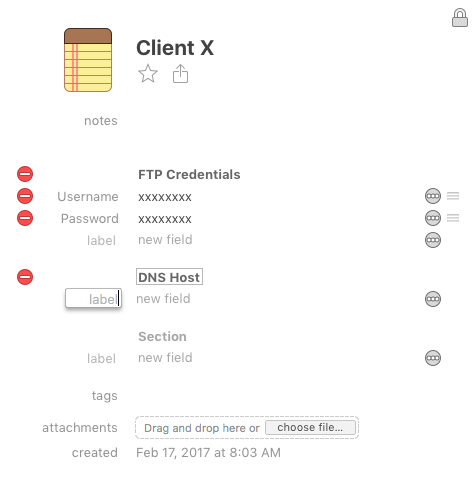
Someone recently sent me this question:
In web design freelancing, besides a contract and a proposal, what other ‘new client’ paperwork, should I include?
As long as your contract and proposal are thorough, those should be enough. You may be asked by the client to sign a non-disclosure agreement, as they will likely be sharing sensitive information about their business when working with you.
A document you may want to keep (at least digitally) for each client is one that includes all of the passwords, licenses, and credentials that you need for the project. These will likely come in as needed throughout the project, so having a central repository of your own for reference is key.
If you have 1Password, you can create a “Secure Note” that is password protected, encrypted, and easy for you to reference as needed (similar programs exist on other platforms).

New client document in 1Password
Work Made for Hire
You may be asked to sign a document that includes a “Work Made for Hire” statement. You may have heard that you should avoid these types of contracts, but first let’s be clear on what it actually is.
By default, any creative work you produce is owned by you, you have the copyright ownership of everything you create. This happens automatically from the moment that you create it, that’s just how our legal system works. In a “work made for hire” agreement, that copyright is automatically assigned to the client who commissioned the work.
Now here comes the crazy part.
No matter what you sign, your design work is unlikely to actually be considered “Work Made for Hire” in a court of law. According to the Definition of Work for Hire, you have to be either employed by the client, or be creating one of the following:
- A contribution to a collective work (like a piece for a magazine, anthology, or encyclopedia)
- A part of a motion picture or other audiovisual work
- A translation
- A supplementary work (like a foreword, afterword, bibliography, appendix, index, or editorial notes)
- A compilation (like an anthology, database, or anything that qualifies as a “collective work” from category 1 above)
- An instructional text (generally, any text that could go in a textbook)
- A test
- Answer material for a test
- An atlas
So, to figure out who really owns the copyright to the work you are performing, you need a thorough contract (see below).
A Thorough Contract
You seem to already have a contract ready as I am assuming from your question. Just for clarification though, I think you should be sure to have the following clauses in there if they aren’t already:
- Pricing Method: Are you pricing by the hour or by the project? Spell that out. Add a minimum and maximum work hour clause to protect yourself from scope creep: “Project X won’t take less than Y hours and no more than Z.”
- Payment Expectations: How are you splitting up the payments? How long do they have to pay? What happens if they don’t pay?
- Single Point of Contact: This is very important if during the question-asking phase you have talked to more than 1 person. Once the contract is underway, you want to spell out the one person responsible for communicating with you. It is a time-suck to have to field questions and requests from multiple people within your client’s organization.
- Kill Fee: In case the project comes to a close, make sure it is spelled out that you are still owed for the work completed up to that point. Some people make sure this is at least 50% of the project cost as well. It’s up to you how you want to structure it.
- Revisions: Depending on the work to be performed, you might want to specify how many revisions of your work are included in the project, and how a client might have to pay for additional rounds.
- Change Requests: Spell out that additional requests, even small ones, need to be accounted for in regards to your compensation. You can either chose to add an additional amount on to your next invoice, or acquire approval to log hours spent small requests here and there that take you outside of the original scope of work.
- Copyrights: There are a couple of ideal ways to work out this clause. First of all, state that you retain the copyright to the work you have performed, but it is licensed to the client for use. This way, you can re-use some code or small design elements on another project without the client claiming that they own the rights to your work. Secondly, you’ll want to spell out that the license does not take effect until payment is made in full.
Of course, the official recommendation is to work with a lawyer to get this all together. However, you can come up with something pretty reasonable by reading through a few sample contracts online and borrowing from them to ensure these clauses are covered.
A Thorough Proposal
Since most of the nitty-gritty is spelled out within the contract, your proposal can focus on winning you this project. Make sure that you spell out clearly the outcomes of the project, the definition of “complete”, and any stated goals or benefits to the client.
More information on how to craft an irresistible proposal: How to Win Larger Contracts as a Freelancer.
Do the hard-work of getting solid documentation in place for your clients, it will make you look more professional, set their minds at ease, and allow you to charge higher rates.







